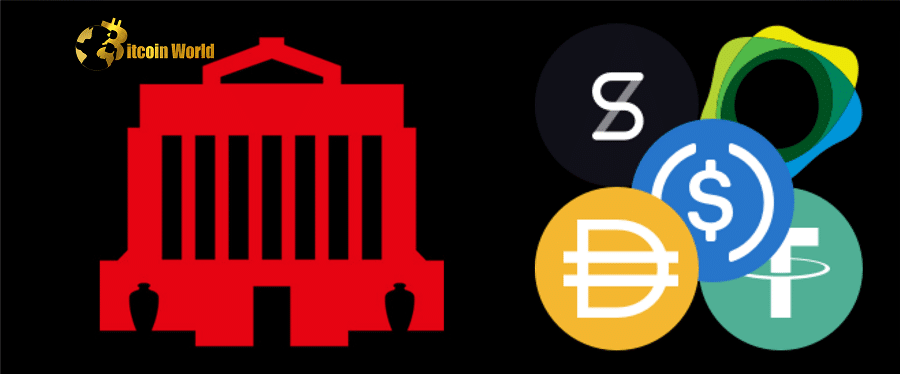Are you keeping up with the rapidly evolving world of cryptocurrency? If you’re invested in digital currencies or just curious about the future of finance, you need to pay attention to stablecoins. These digital assets, designed to maintain a stable value, are gaining serious traction. But with growth comes scrutiny, and the Bank of Canada (BOC) has just released a crucial report highlighting the need for robust stablecoin regulation. Let’s dive into what the BOC is saying and why it matters to you.
What’s the Buzz About Stablecoins?
In a recent report titled “Potential Benefits and Major Risks of Fiat Reference Cryptocurrency” – let’s just call them ‘stablecoins’ for short – the Bank of Canada (BOC) has officially weighed in on how these digital currencies should be governed. Why is this important? Because stablecoins are no longer niche; they’re becoming a significant part of the crypto landscape.
Think of stablecoins as the bridge between the volatile world of cryptocurrencies and the steadier realm of traditional fiat currencies like the Canadian dollar or the US dollar. They aim to offer the best of both worlds: the speed and efficiency of crypto transactions with the price stability we expect from regular money.
According to the Bank of Canada’s report, the stablecoin market has exploded. It grew a whopping 30 times between early 2020 and mid-2022, reaching a massive US$161 billion market cap. That’s not pocket change! They’re primarily used within crypto exchanges for trading and payments, but their potential is much broader.
Why Does the Bank of Canada Care About Stablecoins?
The BOC isn’t just idly observing from the sidelines. They’re actively involved because stablecoins are starting to act like, well, money. As the report states:
“Stablecoins have the potential to take on many of the roles of money…”
This is a big deal! When something starts behaving like money, central banks take notice. The BOC recognizes the potential upsides, acknowledging that:
“…if designed and regulated well, they could make payment services in a digitalized economy more efficient and competitive.”
Imagine faster, cheaper, and more accessible digital payments. That’s the promise of well-regulated stablecoins. But, and this is a crucial ‘but’, the BOC also emphasizes the flip side.
What Are the Risks? The BOC’s Red Flags
The report isn’t all sunshine and roses. The Bank of Canada is concerned about the potential risks if stablecoins aren’t properly managed. They clearly state:
“…the stability of the financial system can be put at serious risk if there aren’t enough safeguards.”
So, what are these risks? The BOC highlights a few key concerns:
- Concentration of Power: A significant portion of the stablecoin market is controlled by a few major players.
- Centralization Concerns: The report points out that Tether (USDT), USD Coin (USDC), and Binance Dollar (BUSD) dominate the market.
- Whale Domination: A small percentage of investors hold a vast majority of stablecoin assets. The top 1% own approximately 90% or more of major stablecoin assets. This concentration of ownership could lead to systemic risks.
Let’s break down the concentration issue further. Consider these numbers from the BOC report:
| Stablecoin | Market Share (as mentioned in report) |
|---|---|
| Tether (USDT) | 44% |
| USD Coin (USDC) | 33% |
| Binance Dollar (BUSD) | 13% |
These three stablecoins alone make up a significant portion of the market. While not inherently bad, such concentration means that the failure or instability of even one of these could have ripple effects across the entire crypto ecosystem and potentially beyond.
Is Current Regulation Enough? The BOC Says No
The Bank of Canada is quite clear on this point:
“Most existing regulatory frameworks in Canada and elsewhere are not good enough to spread the risk of cryptocurrencies.”
This is a call to action! Current regulations are insufficient to manage the risks posed by stablecoins. The BOC is urging for a proactive approach:
“We will try to come up with and put into place a timely and thorough regulatory approach…”
This means we can expect to see more discussions and potentially new regulations aimed at stablecoins in Canada in the near future. The goal? To create a framework that fosters innovation while safeguarding the financial system.
What Does This Mean for You?
Whether you’re a crypto enthusiast, an investor, or just someone interested in the future of money, the Bank of Canada’s stance on stablecoin regulation is something to watch. Here’s why it matters:
- Increased Scrutiny: Expect more regulatory attention on stablecoins and the broader crypto market.
- Potential for Safer Crypto: Proper regulation could lead to a more stable and trustworthy crypto environment in the long run.
- Impact on Innovation: The right regulations can encourage responsible innovation in the digital currency space.
- Future of Payments: Stablecoins could play a significant role in shaping the future of digital payments, and regulation will determine how this unfolds.
In Conclusion: Balancing Act for a Digital Future
The Bank of Canada’s report is a clear signal: stablecoins are important, they’re growing rapidly, and they need proper regulation. It’s about striking a balance – harnessing the potential benefits of stablecoins to enhance digital payments and financial efficiency, while mitigating the risks to protect financial stability. The conversation around stablecoin regulation is just beginning, and it’s a conversation that will shape the future of digital finance in Canada and beyond. Stay tuned, because the rules of the digital money game are being written right now!
Disclaimer: The information provided is not trading advice, Bitcoinworld.co.in holds no liability for any investments made based on the information provided on this page. We strongly recommend independent research and/or consultation with a qualified professional before making any investment decisions.


